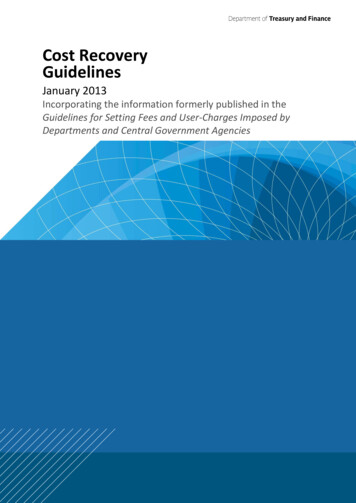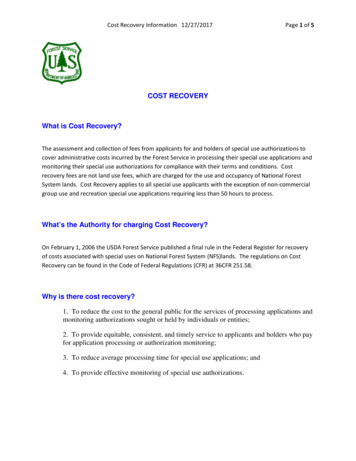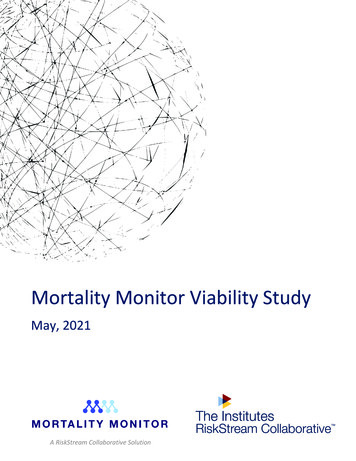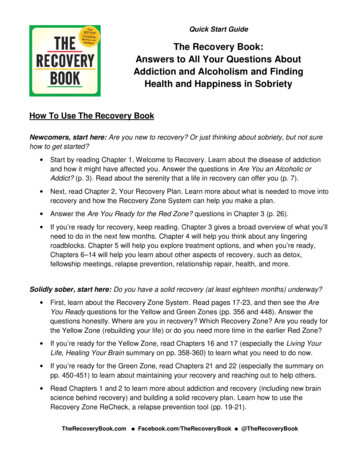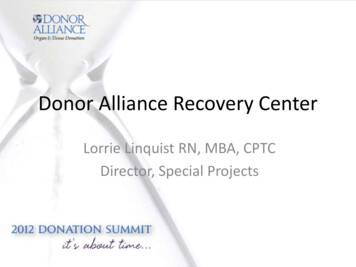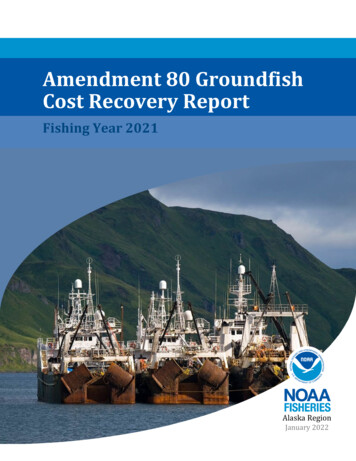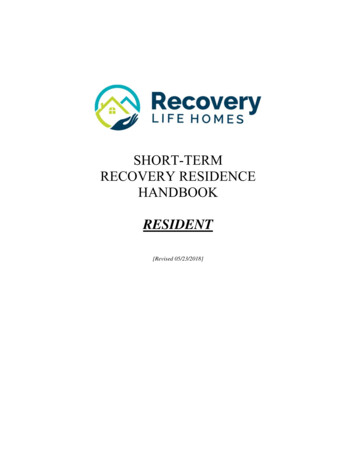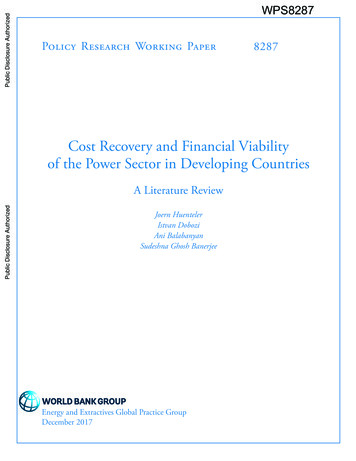
Transcription
Public Disclosure AuthorizedPublic Disclosure AuthorizedPolicy Research Working Paper8287Cost Recovery and Financial Viabilityof the Power Sector in Developing CountriesA Literature ReviewJoern HuentelerIstvan DoboziAni BalabanyanSudeshna Ghosh BanerjeePublic Disclosure AuthorizedPublic Disclosure AuthorizedWPS8287Energy and Extractives Global Practice GroupDecember 2017
Policy Research Working Paper 8287AbstractThe financial viability of the power sector is a prerequisite for attracting the investment needed to ensure reliableenergy supply, meet universal access targets, and hastenthe clean energy transition. Adequate pricing of electricityto allow for cost recovery is also important to minimizethe power sector’s negative macroeconomic, fiscal, environmental, and social impacts. This paper takes stock of theempirical and conceptual literature on the financial viabilityand cost recovery of the power sector in developing countries. Time-series data across countries are relatively scarce,but comparing the findings from 21 studies suggests thatunder-recovery of costs remains pervasive despite decadesof efforts by governments and development institutions.Large electricity subsidies continue to burden governments,especially in the Middle East, South Asia, Central Asia,and Sub-Saharan Africa. Reviews by the World Bank andInternational Monetary Fund on outcomes of their ownengagement also conclude that progress on cost recovery insupported countries has been limited. Although the aggregated view obscures fluctuation within individual countriesover time, the available evidence suggests that countriesprogressing toward cost recovery may find themselvesbacksliding within a few years. As for understanding thecircumstances under which progress can be made, a handfulof studies point toward a correlation between sector reformsand cost recovery, although few of the studies address obvious endogeneity problems. To provide more solid guidancefor future efforts to improve cost recovery, more research isneeded on: (i) the determinants and enabling conditions ofprogress on cost recovery; (ii) tariff reform sequencing; and(iii) institutional arrangements, policies, and regulations thatenable countries to sustain cost recovery once it is reached.This paper is a product of the Energy and Extractives Global Practice Group. It is part of a larger effort by the WorldBank to provide open access to its research and make a contribution to development policy discussions around the world.Policy Research Working Papers are also posted on the Web at http://econ.worldbank.org. The authors may be contactedat jhuenteler@worldbank.org.The Policy Research Working Paper Series disseminates the findings of work in progress to encourage the exchange of ideas about developmentissues. An objective of the series is to get the findings out quickly, even if the presentations are less than fully polished. The papers carry thenames of the authors and should be cited accordingly. The findings, interpretations, and conclusions expressed in this paper are entirely thoseof the authors. They do not necessarily represent the views of the International Bank for Reconstruction and Development/World Bank andits affiliated organizations, or those of the Executive Directors of the World Bank or the governments they represent.Produced by the Research Support Team
Policy Research Working Paper 8287AbstractThe financial viability of the power sector is a prerequisite for attracting the investment needed to ensure reliableenergy supply, meet universal access targets, and hastenthe clean energy transition. Adequate pricing of electricityto allow for cost recovery is also important to minimizethe power sector’s negative macroeconomic, fiscal, environmental, and social impacts. This paper takes stock of theempirical and conceptual literature on the financial viabilityand cost recovery of the power sector in developing countries. Time-series data across countries are relatively scarce,but comparing the findings from 21 studies suggests thatunder-recovery of costs remains pervasive despite decadesof efforts by governments and development institutions.Large electricity subsidies continue to burden governments,especially in the Middle East, South Asia, Central Asia,and Sub-Saharan Africa. Reviews by the World Bank andInternational Monetary Fund on outcomes of their ownengagement also conclude that progress on cost recovery insupported countries has been limited. Although the aggregated view obscures fluctuation within individual countriesover time, the available evidence suggests that countriesprogressing toward cost recovery may find themselvesbacksliding within a few years. As for understanding thecircumstances under which progress can be made, a handfulof studies point toward a correlation between sector reformsand cost recovery, although few of the studies address obvious endogeneity problems. To provide more solid guidancefor future efforts to improve cost recovery, more research isneeded on: (i) the determinants and enabling conditions ofprogress on cost recovery; (ii) tariff reform sequencing; and(iii) institutional arrangements, policies, and regulations thatenable countries to sustain cost recovery once it is reached.This paper is a product of the Energy and Extractives Global Practice Group. It is part of a larger effort by the WorldBank to provide open access to its research and make a contribution to development policy discussions around the world.Policy Research Working Papers are also posted on the Web at http://econ.worldbank.org. The authors may be contactedat jhuenteler@worldbank.org.The Policy Research Working Paper Series disseminates the findings of work in progress to encourage the exchange of ideas about developmentissues. An objective of the series is to get the findings out quickly, even if the presentations are less than fully polished. The papers carry thenames of the authors and should be cited accordingly. The findings, interpretations, and conclusions expressed in this paper are entirely thoseof the authors. They do not necessarily represent the views of the International Bank for Reconstruction and Development/World Bank andits affiliated organizations, or those of the Executive Directors of the World Bank or the governments they represent.Produced by the Research Support Team
Cost Recovery and Financial Viability of the Power Sector in DevelopingCountries: A Literature Review1Joern Huentelera*, Istvan Dobozia, Ani Balabanyana, Sudeshna Ghosh BanerjeeaaEnergy & Extractives Global Practice, The World Bank.*Corresponding author: jhuenteler@worldbank.org; 1 202 458 8646.Keywords: Electricity pricing; electricity tariffs; cost recovery; electricity subsidies; financial viability;developing countries; emerging marketsJEL codes: D12, L11, L94, L98, Q411This paper is a product of the “Rethinking Power Sector Reform” knowledge program of the Energy & Extractives GlobalPractice of the World Bank. Any views presented here are the authors alone and should not be attributed to the World Bank orany other person or institution. The authors are very grateful for financial support from the Energy Sector ManagementAssistance Program (ESMAP) and the Public Private Infrastructure Advisory Facility (PPIAF). Thanks are due to Vivien Foster,Sheoli Pargal, and Chris Trimble acted as peer reviewers. Any shortcomings are the sole responsibility of the authors.
Cost Recovery and Financial Viability of the Power Sector in Developing Countries: A Literature ReviewTable of ContentTABLE OF CONTENT. 21.INTRODUCTION . 52.WHAT DO WE MEAN BY COST RECOVERY AND FINANCIAL VIABILITY? . 73.WHY DO COST RECOVERY AND FINANCIAL VIABILITY MATTER? .103.1.3.2.3.3.4.HOW HAS THE THINKING ON COST RECOVERY AND FINANCIAL VIABILITY EVOLVED?.144.1.4.2.4.3.5.COST RECOVERY LEVELS IN DEVELOPING COUNTRIES .19GAPS IN THE LITERATURE .21WHAT ARE THE CHALLENGES TO ACHIEVEMENT OF COST RECOVERY AND FINANCIAL VIABILITY? .286.1.6.2.6.3.6.4.6.5.6.6.6.7.7.PARADIGM SHIFTS IN THE LITERATURE ON COST RECOVERY AND FINANCIAL VIABILITY (1960S‐2010S) .14COST RECOVERY AND FINANCIAL VIABILITY IN THE 1990S’ POWER SECTOR REFORM PARADIGM .17GAPS IN THE LITERATURE .18HAVE COST RECOVERY AND FINANCIAL VIABILITY IMPROVED OVER TIME? .195.1.5.2.6.IMPACTS ON PROJECT AND SECTOR PERFORMANCE .10MACROECONOMIC, SOCIAL AND ENVIRONMENTAL IMPACTS .12GAPS IN THE LITERATURE .13BASIS FOR DETERMINING PRICING .28DESIGN OF TARIFF STRUCTURE.29CONCERNS ABOUT IMPACTS ON AFFORDABILITY AND INFLATION .30LINKAGES TO STRUCTURAL POWER SECTOR REFORM.34SUSTAINING COST RECOVERY AND FINANCIAL VIABILITY .34ADAPTATION TO NEW RENEWABLES AND DISTRIBUTED ENERGY .36GAPS IN THE LITERATURE .36CONCLUSIONS .37BIBLIOGRAPHY .40ANNEX I: EMPIRICAL APPROACHES TO EVALUATE COST RECOVERY .47ANNEX II: RECENT DATA ON COST RECOVERY LEVELS IN DEVELOPING COUNTRIES .492
Cost Recovery and Financial Viability of the Power Sector in Developing Countries: A Literature ReviewTablesTABLE 1: IMPACTS OF UNDERPRICING OF POWER DISCUSSED AND EXPLORED IN THE LITERATURE .13TABLE 2: STYLIZED OVERVIEW OF PARADIGMS IN THE LITERATURE ON COST RECOVERY AND FINANCIAL VIABILITY, AND THEIR EVOLUTIONOVER TIME .16TABLE 3: ‘LADDER’ MODEL OF UTILITY FINANCIAL VIABILITY. . ERROR! BOOKMARK NOT DEFINED.TABLE 4: MAJOR STUDIES OF COST RECOVERY AND FINANCIAL VIABILITY IN THE POWER SECTOR IN DEVELOPING COUNTRIES. .23TABLE 5: CLASSIFICATION OF STUDIES ACCORDING TO THEIR DATA COVERAGE (GEOGRAPHICAL AND TEMPORAL SCOPE) .26TABLE 6: CLASSIFICATION OF STUDIES BY APPLIED DEFINITION OF COST RECOVERY .26TABLE 7: SHARE OF TOTAL HOUSEHOLD EXPENDITURES SPENT ON ELECTRICITY (KOJIMA ET AL., 2016) .31TABLE 8: MARGINAL WEIGHT OF ELECTRICITY IN THE CONSUMER PRICE INDEX (CPI) .33TABLE 9: RELATIVE WEIGHT OF INDIRECT INFLATIONARY EFFECTS FOR DIFFERENT FUELS, AS INDICATED BY THE SHARES OF INDIRECT EFFECTSOVER TOTAL EFFECTS.33TABLE 10: FACTORS WITHIN AND OUTSIDE SECTOR CONTROL IN AUTOMATIC TARIFF ADJUSTMENTS.35TABLE 11: FINANCIAL PERFORMANCE OF THE LEADING ELECTRICITY UTILITIES IN SELECTED DEVELOPING COUNTRIES .49TABLE 12: INDIA: STATE‐LEVEL COST‐RECOVERY OF RESIDENTIAL TARIFFS IN 2010.49TABLE 13: COST RECOVERY RATIOS IN SUB‐SAHARAN AFRICAN COUNTRIES IN 2014 (CONSTANT 2014 US PER KWH BILLED). .49TABLE 14: SUB‐SAHARAN AFRICA: BREAKDOWN OF HIDDEN COSTS, 2014 (% OF CURRENT GDP). .51FigureFIGURE 1: TARIFF COST RECOVERY AND QUALITY OF ELECTRICITY SUPPLY IN SUB‐SAHARAN AFRICA .10BoxesBOX 1: COUNTRY EXPERIENCE ON IMPACTS OF SUSTAINED LACK OF FINANCIAL VIABILITY (THE WORLD BANK AND IEG, 2016). .11BOX 2: COUNTRY‐LEVEL TRENDS IN COST RECOVERY AND KEY DRIVERS OF FLUCTUATION (VAGLIASINDI AND BESANT‐JONES 2013). .27BOX 3: EMPIRICAL EVIDENCE FOR WTP FOR SELECTED COUNTRIES .323
Cost Recovery and Financial Viability of the Power Sector in Developing Countries: A Literature ReviewAbbreviations and MCMCOPEXPSPQFDVATWTPAVERAGE COSTAFRICA INFRASTRUCTURE COUNTRY DIAGNOSTICCAPITAL EXPENDITURESCONSUMER PRICE INDEXEUROPE AND CENTRAL ASIAENERGY SECTOR MANAGEMENT AND ASSISTANCE PROGRAMGROSS DOMESTIC PRODUCTGREENHOUSE GASESGENERAL SALES TAXINTERNATIONAL ENERGY AGENCYINDEPENDENT EVALUATION GROUPINTERNATIONAL MONETARY FUNDLONG‐RUN MARGINAL COSTMARGINAL COSTOPERATING EXPENDITURESPRIVATE SECTOR PARTICIPATIONQUASI‐FISCAL DEFICITVALUE‐ADDED TAXWILLINGNESS TO PAY4
1. Introduction1.Financial viability of the power sector is a prerequisite for attracting the investment needed foruniversal access to affordable, reliable, and sustainable electricity and the transition towards clean energy(The World Bank and IEG, 2016, 2014a). However, chronic poor financial performance of electricityutilities is pervasive in the developing world—resulting from underpricing, excessive losses, and billcollection failure—and has for decades been a main driver of investment shortfalls, power shortages, poorquality of supply. Electricity subsidies needed to keep utilities afloat have long‐term macroeconomic,fiscal, social ramifications, as they limit the fiscal resources available for other public services, includingclean water, education, health and social protection (Komives et al., 2007; Saavalainen and ten Berge,2006; Sdralevich et al., 2014). Underpricing of electricity also increases levels of pollution and otherenvironmental impacts (Badiani et al., 2012; IEA et al., 2010; Monari, 2002; Rentschler and Bazilian, 2016).2.Making electricity services financially viable and recovering the cost of service have long beencore objectives of power sector reform2 in developing countries (The World Bank, 1993a, 1993b). Publicutilities’ limited ability to finance expansion of capacity to meet growing demand was a main argumentfor power sector reform in the developing world in the 1990s, and raising tariffs to cost recovery levelshas therefore been a sine qua non of the ‘standard menu’ for power sector reform (ESMAP, 1999). In somecases, tariff reforms were part of a homegrown reform program to improve macro‐economic and serviceconditions. In many other countries, raising tariffs was a condition for assistance by the donors andmultilateral institutions to reduce the fiscal burden from the power sector (The World Bank, 1996;Williams and Ghanadan, 2006).3.Almost four decades have passed since Chile began its power sector reform efforts in the 1980sand three since the reform agenda swept through much of the rest of the developing world in the 1990s.Cost recovery and financial viability remain core objectives for institutions such as the World Bank in thepower sector.3 However, overall reform outcomes have often fallen short of expectations and manycountries have chosen to adopt hybrid reform models different from the standard prescription (Besant‐Jones, 2006; Jamasb et al., 2015). A renewed debate among policy makers and in the literature is emergingon the validity of the ‘standard menu’ of the 1990s and the need for a new, more empirically groundedreform paradigm (Jamasb et al., 2015; Vagliasindi and Besant‐Jones, 2013; Williams and Ghanadan, 2006).As in the 1980s and 1990s, the financial performance of the power sector remains at the heart of thisdebate.4.In parallel, especially in recent years, more advanced electricity markets, including in the OECD,have seen a renaissance of subsidies to the power sector as governments aim to stimulate the diffusionof new renewable energy technologies. Zero‐marginal cost renewables and distributed energy are2Power sector reform is understood here as institutional and policy measures aimed at advancing power sectorcommercialization, restructuring, regulation, privatization, tariff rebalancing, and liberalization.3 For example, a recent review found that between 2000 and 2015, the World Bank included sector financial conditions in atleast 41 project loans in 25 different countries (total volume US 5,193mn) as well as 49 development policy loans covering 25different countries (US 10,680mn) (The World Bank and IEG, 2016).5
Cost Recovery and Financial Viability of the Power Sector in Developing Countries: A Literature Reviewchallenging the textbook model of power market reforms (IEA, 2016a). The IEA estimates that subsidiesto wind and solar in the power sector reached around US 120 billion in 2015 (IEA, 2016b). As utility‐scalesolar and wind power make inroads into power sectors outside the OECD, policy makers are grapplingwith questions relating to their impact on sector financial performance and their treatment in electricitypricing.5.This paper aims to inform these debates in policy and academic circles.4 To this end, the papertakes stock of the conceptual and empirical evidence on cost recovery and financial viability of the powersector in the developing world, synthesizes the literature’s findings, explores how the focus of theliterature has evolved over the past decades, and identifies what gaps remain and which hypotheses areemerging on the most important reform issues. Given the focus on technical aspects of cost recovery ofelectricity tariffs and the financial viability of utility services, the political economy of cost recovery andtariff reforms as well as broader aspects of tariff regulation, while important for cost recovery, are beyondthe scope of this paper and have been addressed elsewhere.6.The paper is organized as follows. After introducing the terminology and definitions used (Section2), the paper provides an overview of the literature that addresses cost recovery and synthesizes keydevelopments over time in Section 3. The following three sections elaborate in more detail on specificthemes of the literature: Impacts of under‐recovery of cost on sector and country performance (Section4); empirical evidence on current trends of cost recovery in the developing world (Section 5); and lessonslearned from reform experience (Section 6). Each of these four sections summarizes key findings andrecommendations and the gaps in the literature that call for further research. The last section summarizesthe main conclusions (Section 7).4For a synthesis of the World Bank’s policy guidance on energy subsidy reform, see also the Energy Subsidy AssessmentFramework (https://www.esmap.org/node/3043).6
Cost Recovery and Financial Viability of the Power Sector in Developing Countries: A Literature Review2. What Do We Mean by Cost Recovery and Financial Viability?7.The paper focuses on technical aspects of cost recovery of electricity tariffs, the financial viabilityof electric utility services, and the fiscal sustainability of subsidies for electric utility services. These threeconcepts are closely related and sometimes used interchangeably: one can easily image a scenario whereunderpricing of electricity leads to poor financial viability of a publicly owned utility, which is only restoredthrough a government subsidy. But conceptually the terms are not identical. For the sake of clarity, thefollowing paragraphs lay down how these concepts are defined and how they relate to each other.8.‘Cost recovery’ is understood as an attribute of electricity tariffs and is fulfilled when the averageelectricity tariff aligns with the average cost of service, usually measured as the ratio between tariffs andcosts (often expressed as a percentage).5 For this paper, if not otherwise specified, tariffs refer to averagetariffs across all consumers and costs are defined as ‘full cost of service’, including capital and associatedoperating cost of generation, transmission and distribution, and including the cost of financing newinvestments to sustain the service over time. However, a range of definitions are in use in academic andpolicy circles and, as explored later in this review, the literature uses many different approximations andmeasures for both tariffs and costs in empirical studies.9.‘Financial viability’ is understood as an attribute of utility companies6 and is fulfilled when tariffrevenues together with other sources of income are adequate to cover the cost of service. Cost recoveryof tariffs is obviously a main determinant, but financial viability also depends on the adequacy of cashinflows and outflows (taking into account collection losses and availability of adequate financing) as wellas the sustainability of the company’s balance sheet (most importantly, if the company’s debt and duesare under control). Therefore, while the two mutually reinforce each other and the literature sometimesuses them interchangeably, a utility can be financially viable even if cost recovery is below 100 percent,for example if tariffs are set below cost recovery level but reliable fiscal transfers are made to compensate.Further, analyses of financial viability in the literature often do not differentiate between revenues fromelectricity sales and revenue not related to the sale of electricity (e.g., government transfers); take inputcost at financial value (e.g., fuels, capital, land or labor at subsidized prices); and count SOEs’ contributionto the government’s revenues—e.g., in the form of taxes, duties, and, for SOEs and any mandatoryallocations from profits—as costs. When discussing the financial viability in sectors with multiple utility5Conceptually, cost recovery can be viewed from the perspective of the power utility/sector, fiscal perspective or overalleconomic perspective. In each case, the full costs would be defined differently, and which perspective is appropriate dependson the research question. Further, depending on the purpose, cost recovery may include “full costs” with any inefficiencies(including excess losses) the power company/sector have or cost recovery assuming efficient operation of the company/sector.The latter approach is ideally that taken by the regulators so as not to pass inefficiencies to consumers. Importantly, full costrecovery of tariffs for the sector does not necessarily mean that all individual parts of the supply chain (generation,transmission and distribution) recover their costs, depending on how tariffs are set for the different services. Furthermore,some studies in the literature approximate tariffs with revenues and cost with actual cost incurred by the utilities, bringing theconcept of ‘cost recovery’ closer to the common understanding of ‘financial viability’.6 Financial viability is also an attribute of investment projects and in fact early World Bank studies of financial viability in thepower sector were primarily interested in the ability of individual investments to make adequate returns. However, this viewhas evolved (see Sections 3 and 4) and now the primary unit of analysis in the literature is the utility. This is reflected in theterm’s usage in this paper.7
Cost Recovery and Financial Viability of the Power Sector in Developing Countries: A Literature Reviewcompanies, the term can apply to each company separately or as an aggregate of all companies in thesector.While financial viability is sometimes reported in binary terms, the reality – particularly in thedeveloping world – is that there is a continuum of degrees of financial viability (Trimble et al., 2016).7While it is indisputable that a utility unable to recover operating expenditures (OPEX) is not financiallyviable, the ambiguity arises with capital expenditures (CAPEX), which can be measured in different ways.Utilities may differ according to whether they are only able to recover the debt financing costs associatedwith their existing capital expenditures or the full cost of capital associated with current and plannedfuture capital expenditures (see Table 1).10.Table 1: The ‘Ladder’ of financial viabilityLevel of Financial ViabilityCommentLevel 1: Utility does not cover existing OPEX.Financially unviable, loss‐making utility.Level 2: Utility covers at least existing OPEX.Utility dependent on government for capital investments.Level 3: Utility covers existing OPEX plus concessionalfinancing costs on existing assets.Utility dependent on access to concessional financing.Level 4: Utility covers existing OPEX and full CAPEX forexisting assets.CAPEX based on new replacement value of assets.Level 5: Utility covering efficient OPEX and full CAPEX onexisting and future assets.Future assets based on a least‐cost expansion plan.Level 6: Utility covers efficient OPEX and full CAPEX onexisting and future assets plus environmental externalities.Definition of financial viability that may be used in high‐income economies.Source: Trimble et al. (2016)11.‘Electricity subsidies’ are understood as an attribute of the sector or the economy. Electricitysubsidies can be defined as deliberate government policy actions targeting electricity services that (i)reduce the net cost of electricity or fuels purchased; (ii) reduce the cost of electricity production or servicedelivery; or (iii) increase the revenues retained by the electricity producer or service provider (adaptedfrom Kojima, 2017). This means that electricity can be subsidized irrespective of whether or not the utilityitself incurs a visible cash shortfall, and irrespective of whether or not any visible cash waterfall is coveredby fiscal transfers from the budget (as opposed to commercial borrowing, deferred depreciation, etc.).However, empirically, in the absence of good ways to quantify many forms of implicit and indirectsubsidies, most estimates referred to in this literature review of electricity subsidies either apply relativelysimple methodologies comparing the full cost of service to tariffs or revenues (expressed as absoluteamount or percentage of GDP) or focus on direct budget transfers to utility companies.7 The first step along the ladder is to achieve cost recovery levels 2 or 3 to be able to maintain day‐to‐day operations. However,given the substantial investments required to meet demand and reach universal access by 2030, and the limited availability ofconcessional foreign financing, utilities should progress toward levels 4 and 5 in a reasonably short time frame (Kojima andTrimble, 2016).8
Cost Recovery and Financial Viability of the Power Sector in Developing Countries: A Literature Review12.‘Hidden cost’ and ‘quasi‐fiscal deficit’ are measures of implicit financial losses of the power sector.The quasi‐fiscal deficit is measured as the difference between the revenues that would be collected by autility applying cost recovery tariffs and achieving best practice levels of commercial and operationalefficiency, and the revenues collected by the existing utility. In general, power utilities in most developingcountries are state‐owned and can be considered quasi‐fiscal entities. Typically, these utilities display poorfinancial performance in part because they channel a variety of transfers to consumers throughunderpricing, uncollected bills and other inefficiencies (e.g., excessive network losses, including theft).However, the total cost of such transfers is not reflected in the public budget because a large portion is‘hidden cost’, i.e., implicit or involuntary (e.g., theft). The resulting financial gap in the public utility hasbeen called in the literature quasi‐fiscal deficit, typically expressed as percentage of GDP, or hidden cost,expressed in absolute terms.8 The quasi‐fiscal deficit can usefully be disaggregated to clarify how much isattributable to underpricing, under‐collection or excessive distribution losses.8 According to the most common definition, QFD is the difference between the actual revenue charged and collected atregulated electricity prices and the revenue required to fully cover prudently incurred operating costs of service provision andcapital depreciation: QFD (as % of GDP) Cost of Underpricing
the power sector's negative macroeconomic, fiscal, environ - mental, and social impacts. This paper takes stock of the empirical and conceptual literature on the financial viability and cost recovery of the power sector in developing coun-tries. Time-series data across countries are relatively scarce,
